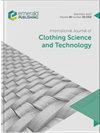基于皮肤组织的电加热织物低温传热性能模拟与分析
IF 1
4区 工程技术
Q3 MATERIALS SCIENCE, TEXTILES
International Journal of Clothing Science and Technology
Pub Date : 2023-03-14
DOI:10.1108/ijcst-02-2022-0021
引用次数: 0
摘要
目的目前,电热衣被广泛用于在低温下保暖。本文旨在探讨电热织物的传热性能和人体皮肤在低温下的热舒适性。设计/方法/方法建立皮肤电热织物系统的组合模型,模拟穿着电热服的人体皮肤组织。在验证组合模型有效性的基础上,设计了一系列仿真实验。模拟分析了不同加热功率下组合模型内部和皮肤表面的温度分布。同时探讨了环境温度对电热织物热性能的影响。结果:带有血管的皮肤模型反映了穿着电热服的人体皮肤的温度变化。电加热织物的加热功率越高,皮肤表面的温度变化越大,温度上升得越快,达到稳定状态所需的时间就越长。加热元件通电后,对表皮和真皮的平均温度影响最大,对皮下平均温度影响较小,对血管温度影响较小。当加热功率相同时,环境温度越高,电加热织物的加热效果越明显。具有不同加热功率的电加热织物适用于不同的环境温度范围。独创性/价值通过建立皮肤电热织物系统的皮肤模型和组合模型,为电热织物的热舒适性评价提供了一种合理有效的方法。为电热服装的设计和应用提供参考。本文章由计算机程序翻译,如有差异,请以英文原文为准。
Simulation and analysis of heat transfer performance of electrical heating fabric at low temperature based on skin tissue
PurposeAt present, electrical heating clothing is widely used to keep ourselves warm at low temperature. The purpose of this paper is to explore the heat transfer performance of electrical heating fabric and the thermal comfort of human skin at low temperature.Design/methodology/approachThe combined model of skin-electrical heating fabric system was established to simulate human skin tissue wearing electrical heating clothing. A series of simulation experiments are designed on the basis of verifying the effectiveness of the combined model. The temperature distribution inside the combined model and on the skin surface under different heating powers is simulated and analyzed. At the same time, the influence of ambient temperature on the thermal performance of electrical heating fabric was explored.FindingsThe skin model with blood vessels reflected the temperature change of human skin wearing electrical heating clothing. The higher the heating power of the electrical heating fabric was, the greater the temperature of the skin surface changed, the faster the temperature rose and the longer the time required to reach the stable state would be. After the heating element was electrified, it had the greatest effect on the average temperature of the epidermis and dermis, had smaller effect on the average temperature of subcutaneous layer and had little effect on the temperature of blood vessels. When the heating power was the same, the higher the ambient temperature was, the more obvious the heating effect of electrical heating fabric was. Electrical heating fabrics with different heating powers were suitable for different ambient temperature ranges.Originality/valueA reasonable and effective evaluation method for the thermal comfort of electrical heating fabric was provided by establishing the skin model and combined model of the skin-electrical heating fabric system. It provides a reference for the design and application of electrical heating clothing.
求助全文
通过发布文献求助,成功后即可免费获取论文全文。
去求助
来源期刊
CiteScore
2.40
自引率
8.30%
发文量
51
审稿时长
10 months
期刊介绍:
Addresses all aspects of the science and technology of clothing-objective measurement techniques, control of fibre and fabric, CAD systems, product testing, sewing, weaving and knitting, inspection systems, drape and finishing, etc. Academic and industrial research findings are published after a stringent review has taken place.

 求助内容:
求助内容: 应助结果提醒方式:
应助结果提醒方式:


